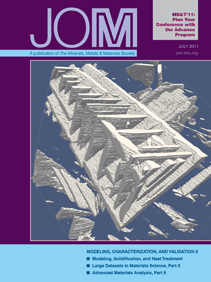 |
TMS ONLINE | TMS PUBLICATIONS | SITE MAP JOM Material Matters Articles in Full-Text Format: April 2006 |
Exploring traditional, innovative, and revolutionary issues in the minerals, metals, and materials fields. |
|||||
| OUR LATEST ISSUE | |||||
VISIT THE JOM COVER GALLERY
|
Watch What You Say—Appellate Court Clarifies Standards for Interpreting Technical Patent Claim LanguageArnold B. SilvermanHow a court interprets a single word in a patent claim could determine whether it concludes that patent infringement does or does not exist. The United States Court of Appeals for the Federal Circuit (CAFC), which is the court of appeals that rules on appeals from the federal district courts in patent cases, recently overruled a CAFC 2002 decision regarding how ambiguous technical terms in patent claims are to be interpreted. The law is clear that a patent speaks to those persons of ordinary skill in the art to which it relates as contrasted with being written to be understood by an ordinary member of the public. When a term in a patent claim is deemed to be ambiguous, it is important to determine how that term would be understood insofar as the ordinary and customary meaning the term would have to one skilled in the art. As a patentee can be his or her own lexicographer and can modify the ordinary meaning and have the modified meaning govern claim interpretation, an important issue is whether analysis of an ambiguous technical term is to be made by looking at intrinsic evidence or extrinsic evidence. A patent application by statute must contain a specification which has a written description of the invention and the manner and process of making and using it in such full, clear, concise, and exact terms as to enable any person skilled in the art to which it pertains to make and use the same. It also has a series of numbered paragraphs called claims, which in words define the property for which an exclusionary right is being sought. The application may also contain drawings. The patent statute states that claims must point out and distinctly claim the subject matter which the applicant regards as his invention. Intrinsic evidence refers to the written specification, the claims, drawings, and, where it would be helpful, the file wrapper or prosecution history. The file wrapper or prosecution history consists of the communications between the applicant and the Patent and Trademark Office during processing of the application. Extrinsic evidence refers to resources which one skilled in the art or the general public might access in order to gain additional information regarding the technology involved. Among primary extrinsic resources that have been consulted previously are dictionaries and scholarly treatises. In the 2002 CAFC case, which was overruled by the more recent Phillips case, primary emphasis was given to dictionary meanings in interpreting what a term would mean to one of ordinary skill in the art. In the Phillips case, priority was given to the intrinsic evidence. One could resort to the specification and other elements of intrinsic evidence for clarification. This does not mean that a claim must be limited to the specific embodiments disclosed in the application or that limitations not recited can freely be read into a claim. The court in Phillips concluded that while not precluding access to dictionaries and other extrinsic evidence in certain circumstances, the best evidence was the actual words employed by the inventor. By contrast with dictionaries, which may have multiple meanings for a given term, the inventor may advantageously provide specific definitions regarding the meaning to be given the same term in his or her application. Such definitions can be very effective in minimizing or eliminating ambiguity. Another intrinsic element that can be considered is the use of the identical term in claims other than the one in which the term is used ambiguously to see if clarification of meaning can be obtained in that fashion. The prosecution history, while part of the intrinsic evidence, is not as reliable an indication of meaning as it involves an advocate’s give-and-take with the Patent and Trademark Office. Therefore, it is important to employ in the claims technical terms, the meanings of which are clear. One also may employ the specification and, where appropriate, the drawings to make sure that the technical disclosure is clear. One may also employ the file wrapper during patent prosecution to attempt to clarify any claim terms that might be ambiguous. One of the best approaches to doing this is to provide special definitions in the specification where the term is not to have its ordinary and customary meaning to those skilled in the art and, in some instances, even where it has to have such ordinary and customary meaning. It is important when preparing a patent application to keep in mind in this context that additional language contained in the specification, but not in the original patent application claims, may later be introduced into the claims and, therefore, be subject to the same scrutiny. Arnold B. Silverman is chair of the Intellectual
Property department and a member of Eckert
Seamans Cherin & Mellott, LLC in Pittsburgh,
Pennsylvania. |
Copyright © 2006 by The Minerals, Metals & Materials Society.
Direct questions about this or any other JOM page to jom@tms.org.
